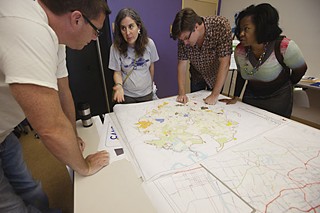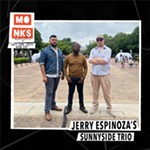Point Austin: Imagine Affordability
How Austin can avoid becoming 'home to the very wealthy and the very poor'
By Amy Smith, Fri., Oct. 7, 2011

Last Saturday, under bright-blue skies and a kinder, gentler sun, hundreds of residents walked through the doors of the Carver Museum & Cultural Center in East Austin to catch a glimpse of what Austin might look like 10 to 30 years down the road. The indoor-outdoor event, billed as a "release party" for the Imagine Austin Comprehensive Plan, included musical entertainment, promotional swag, food trailers, and – everyone's favorite – face painting.
The biggest surprise was the sheer number of people – the city's estimate was about 600 – who turned out for an event that featured city planning as the main attraction. Apart from the political and policy wonks, the "regular" part of the crowd included a broad mix of people young and old. They strolled through the venue studying various maps and literature. Members of the Citizens Advisory Task Force that hammered out the plan were on hand to answer questions, along with a cadre of planning consultants and city leaders.
Like other ambitious planning road maps before it, the Imagine Austin plan lays out a vision for a compact city with more connectivity between neighborhoods. It lists eight "action programs" that essentially boil down to a short list covering the environment, schools, transportation, land use, and the elusive affordable housing component. And the plan, like so many others, includes a vision statement that seeks to preserve the quality of life and unique character that has defined Austin, which – I'll just throw this out there – appears through my sights to be growing more homogenized and more expensive with every boom year.
All Together Now
Which leads us back to affordable housing.
But first, a quick rundown of the next steps for Imagine Austin: The plan will continue to develop over the coming months as it winds through a series of task force tune-ups and reviews by various boards and commissions before it's handed off to City Council. Garner Stoll, assistant director of Planning and Development Review, expects the comp plan to be ready for council's stamp of approval by next spring.
In theory, affordability is one of the key drivers of the comp plan. On paper, it always looks so possible to achieve, but city leaders past and present have been talking about affordable housing for many years. And while they were talking, Austin was transitioning from a cheap town to live in to one of the most expensive cities in Texas.
Thankfully, the new comp plan lays out a vision for preserving what remains of Austin's affordable housing communities. That sounds like a good place to start. One tool already available for helping to flesh out the preservation element of the plan is a strategic report, "Building and Retaining an Affordable Austin," released last year by HousingWorks Austin, a nonprofit that promotes affordable housing "through research, education and public policy change."
What's unique about this particular report is that it came together as a collaborative effort involving the Urban Land Institute, the Austin Area Research Organization, and the Real Estate Council of Austin, and it was written with an attentive eye on the comp plan. Now, affordable housing doesn't immediately spring to mind when one thinks of RECA, so that's why the HousingWorks report is an important step forward in achieving affordable housing through the comprehensive plan.
"If all you have are nonprofits trying to build affordable housing, then you don't get enough," said Frances Ferguson, board president of HousingWorks and a member of the comp plan task force. "So that's why we wanted to do this report with [RECA, et al.], because ultimately, if we're going to keep the city affordable, you need to have policies that the private sector also will work with."
Welcome Your Neighbors
The HousingWorks report offers some sobering news about the challenges ahead. By 2020, the city will need at least 16,500 housing units to meet the demand of residents earning less than $20,000. Similar housing hardship warnings apply for middle-income professionals – teachers and the like who landed in fields that don't make people rich. Without a diverse supply of affordable housing in all parts of town, "concentrated poverty is the inevitable consequence," the report warns. "If the trend is not contained, the fear is that the city of Austin will become home to only the very wealthy and the very poor."
One of Ferguson's key focuses is on housing preservation – a skill she honed in her former role as executive director of Foundation Communities, a nonprofit specializing in affordable rental properties. "It's cheaper, greener, and faster to preserve existing housing instead of building something new – not to tear down trees, use all the electricity, and mine more metal, and dump all that stuff in landfills," she said. To avoid a repeat of the development trend of turning cheap apartments into high-end condos, Ferguson says the city needs to have a preservation policy in place. Such a policy will ultimately require public subsidy for the city or public-private entities to purchase existing properties, as well as to create a mix of housing communities across the city – sort of along the lines of the mixed-income homes and apartments in the redeveloped Mueller community.
Of course, the affordability issue and other goals laid out in the comp plan will require changes to the city's land-use code once the plan is adopted.
One other hurdle that needs to be cleared is the fear of "affordable housing" coming to a neighborhood near you. That's why mixed-income communities have been so successful in seamlessly placing lower-income residents in the same neighborhoods as mid- to high-income residents. One of HousingWorks' annual events is to fill a couple of buses with local leaders and take them on a tour of affordable housing properties in Austin. The reason? "So they can understand that affordable housing isn't scary," Ferguson said. "Affordable homes are all over the place – they come in all kinds of shapes and sizes. We could have them all over our city and not damage anybody's property values. In fact, we do ... we just need more." The housing stock, she continued, "is actually any city's most fundamental infrastructure decision."
On a related housing topic, City Council will hold a public hearing at 4pm today, Thursday, Oct. 6, on the Downtown Austin Plan, which is expected to address a lack of affordable housing Downtown.
Got something to say on the subject? Send a letter to the editor.











